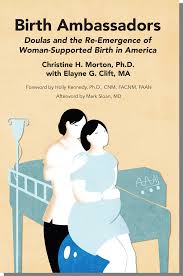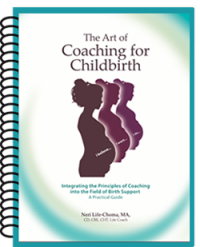Recently I have read the wonderful book Birth Ambassadors, which I find to be the most comprehensive and eye-opening study about doulas and birth support in North America.The book is a genuine presentation of the doula role, ways of  practice and training system in America from a sociological point of view. As such, it is free of any judgments about the dilemmas in the field, and views them from the perspective of sociological interests, such as professional status, the emergence of occupational niche, change agents in maternal care, community service, income level and even organizational developments. This point of view allows the author to also question, or re-open for discussion, some of the most common assumptions doulas and birthing moms ascribe to, including the benefits of doula care in terms of increasing normal births, and the doula’s agenda favoring natural birth, as well as doula advocacy in labor and delivery.
practice and training system in America from a sociological point of view. As such, it is free of any judgments about the dilemmas in the field, and views them from the perspective of sociological interests, such as professional status, the emergence of occupational niche, change agents in maternal care, community service, income level and even organizational developments. This point of view allows the author to also question, or re-open for discussion, some of the most common assumptions doulas and birthing moms ascribe to, including the benefits of doula care in terms of increasing normal births, and the doula’s agenda favoring natural birth, as well as doula advocacy in labor and delivery.
To me, the most urgent dilemma is the one regarding doulas’ professional status. It is my understanding that this is also the core dilemma, the one that originates the others. In literature and doula guides, one cannot escape the choice of words used to name and describe this role by those who are perceived as the biggest doula advocates. Morton describes doulas for her readers using a typical definition, “Doulas are birth companions…The word doula comes from the Greek and refers to a woman who personally serves another woman.” Neither a ‘companion’ nor a ‘doula’ implies any professional position—the latter evokes servitude rather than social change agents that come from being a mentor, a teacher, a coach or a leader. Yet, doulas are trained to believe that they can and do make change. Morton’s discussion of Klaus and Kennell’s book “Mothering the Mother,” the book that still, three decades after their emergence in America, provides doulas with the scientific data of the benefits they bring, provides additional food for thought about how doulas are described. The title “Mothering the Mother” is another poor choice of words. As we all know, mothering is considered to be a non-professional position, and although everyone agrees that it is the hardest and most valuable work of all, mothers do not get paid for all they do.
The non-professional status of doulas in North America is reflected in the current training and certification system. Morton points out that research findings regarding doula benefits were actually based on a control group comprised of inexperienced and untrained women who sat in the delivery room and took notes. Most doula trainings in North America are between a two-four days’ workshop. In comparison, I was trained in Israel, where doula training programs last a year and are usually affiliated with an alternative medical college and/or hospital. Trainees are required to have an internship inside Labor and Delivery. As a sociologist, Morton points out the dilemma of doulas as being committed to providing humanistic and affordable childbirth support within the community, similar to what existed in a more tribal society before women began giving birth in hospitals, and the current situation of low status, low income and low professional standards for doulas as working women.
Morton continues to point out another motivation to maintain the non-professional status of doulas, which is closely tied with the circumstances of doulas’ historical origins. As Morton observes: “Doula care emerged as a unique response to the changing social and medical context of childbirth support in the United States” and “…the fragmentation of childbirth support [that] began with biomedical experts claiming authority over pregnant women’s health and childbirth outcomes and moving birth to the hospital…it is in this period we see the emergence of the doula as a particular, specialized role in providing non-medical support to pregnant women. “ In other words, doulas emerged in the United States as a reaction to the medicalization of birth, yet they are largely practicing within the medical system, holding to a philosophy of care and birthing model that are alien and unfamiliar in the medical paradigm. It is my assumption that doulas organizations are confusing professional status with medical status. If doulas were to claim medical authority they would not be able to practice within labor and delivery. While it is important to keep doulas as non-medical care givers, it is most important to elevate and state their professional status as coaches and care givers in the field of birth. Until then doulas are left with being viewed as community service or support figures whose motivation for their work ‘comes from the heart’.
Morton goes on to explain the controversy, facing doulas in terms of how they advocate in birth. In their current status as non-professional community service workers, how can doulas be an authoritative source for evidence-based care and empower their clients to question the medical staff and the care they provide?
I can see how some doulas and doula trainers in North America might feel challenged by this book, but I believe that this challenge is an invitation to initiate a healthy change in our occupational niche. Morton contributes to the well-being of doulas and birthing moms, by opening our eyes to the reality of birth support in North America. As a birth coach trainer, I would like to encourage all doulas to abandon the term ‘doula’ and the connotations attached to it over the past decades. I recommend that we begin a new era of re-defining doulas as birth coaches, who can acquire coaching tools and skills, and enjoy the accreditation experienced by coaches in many other fields (such as life coaching, executive coaching etc.) The coaching model and practice standards can resolve some of the dilemmas Morton identifies as problematic for doulas and their organizations, such as the advocacy dilemma, or practicing within the territory of doula support without wrongly step into the medical territory, as well as coaching the mother prenatally for the performance of childbirth. To read more about the coaching model, read my blog post on birth coaches vs. doulas at: https://birthcoachmethod.com/imagine-giving-birth-profession-doula-profession-change/.












